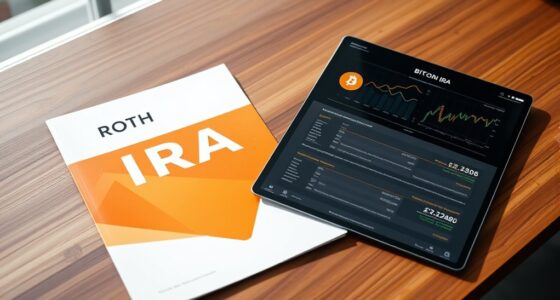In 2024, several Bitcoin IRA providers stand out as leaders in the crypto investment space. iTrustCapital offers a low minimum investment of $1,000 and supports 34 cryptocurrencies, with just a 1% transaction fee. Bitcoin IRA shines with access to over 60 cryptocurrencies and $700 million in insurance protection. BitIRA focuses on security with multi-encryption and cold storage, while Coin IRA has no setup fees and emphasizes education. Each provider has unique strengths, so it's essential to assess which aligns best with your investment goals. Discovering the nuances of these options can further enhance your crypto journey.
Key Takeaways
- iTrustCapital leads with a low minimum investment of $1,000 and supports 34 cryptocurrencies, making it accessible for many investors.
- Bitcoin IRA stands out for offering access to over 60 cryptocurrencies and $700 million in insurance protection.
- BitIRA emphasizes security with multi-encryption storage and insurance coverage, requiring a minimum investment of $5,000.
- Coin IRA offers no setup or maintenance fees, focusing on educational resources and requiring a $5,000 minimum investment.
- My Digital Money is recognized for its strong security measures and custody insurance up to $700 million, appealing to risk-averse investors.
Understanding Bitcoin IRAs

In recent years, Bitcoin IRAs have gained traction as a way for you to invest in cryptocurrencies within a retirement account. These self-directed retirement accounts allow you to enjoy tax advantages similar to traditional IRAs, including tax-deferred growth and potential tax-free withdrawals.
The IRS classifies cryptocurrencies like Bitcoin as property, meaning your transactions could be subject to capital gains tax regulations, which affects how you report gains and losses.
Minimum investment requirements for Bitcoin IRAs can vary markedly among providers, with platforms like iTrustCapital allowing you to start with just $1,000, while others like BitIRA and Coin IRA may require a minimum of $5,000.
One of the key benefits you'll appreciate is the secure storage options offered by many providers. These include cold storage solutions and insurance on your digital assets, protecting you against hacks and theft. For instance, BitIRA provides end-to-end insurance coverage for added peace of mind.
As cryptocurrencies gain acceptance as a legitimate asset class, Bitcoin IRAs offer you diversification benefits for your retirement portfolio, especially in times of economic uncertainty.
Embracing this investment route could be a smart move for your financial future.
Leading Bitcoin IRA Providers

As you're exploring Bitcoin IRAs, it's important to contemplate the leading providers in the market that can help you maximize your investment potential.
iTrustCapital stands out with a low minimum investment amount of just $1,000, supports over 34 cryptocurrencies, and charges a competitive 1% transaction fee, making it ideal for new investors.
Bitcoin IRA is another strong contender, offering the widest selection of 60 cryptocurrencies. Its minimum investment requirement is $3,000, and it provides a substantial $700 million in insurance protection for your digital assets.
BitIRA emphasizes security with multi-encryption storage and offers full insurance for digital assets, but it requires a minimum investment of $5,000 and supports 15 cryptocurrencies.
If you're keen on education, Coin IRA might be your go-to. It has no account setup or ongoing maintenance fees, requires a $5,000 minimum investment, and focuses on educating investors about cryptocurrency.
Finally, Equity Trust, established in 1974, allows trading in up to eight cryptocurrencies and emphasizes self-directed IRA management, though its annual administration fees can range from $225 to $2,250.
Each Bitcoin IRA provider offers unique features tailored to different investor needs.
Security Features of Providers

When considering Bitcoin IRA providers, security features play a critical role in protecting your investments. You want to know that your digital assets are safeguarded against potential threats.
BitIRA stands out with its multi-encryption encoding, storing physical keys in grade-5 nuclear bunkers to guarantee robust security.
Bitcoin IRA also takes security seriously, providing $700 million in insurance protection for your digital assets, along with secure offline storage and 256-bit SSL encryption.
iTrustCapital partners with Fortress Trust Company for asset custody, emphasizing security through reliable custodial services. This collaboration guarantees that your investments aren't only competitive regarding rates but also secure.
My Digital Money boasts a perfect security track record and offers extensive custody insurance, covering deposits up to $700 million with military-grade security protocols.
Coin IRA enhances security by holding assets in off-balance-sheet cold storage, greatly reducing risks associated with hacking and unauthorized access.
Fees and Investment Requirements

Maneuvering the fees and investment requirements of Bitcoin IRA providers can feel overwhelming, but understanding these factors is essential for making informed decisions. Each provider has different minimum investment amounts and fee structures that can impact your overall returns.
For instance, iTrustCapital stands out with a low minimum investment requirement of just $1,000 and charges a competitive 1% transaction fee per trade, making it an attractive choice for new investors.
On the other hand, Bitcoin IRA requires a higher minimum investment of $3,000 and comes with elevated administration and storage fees, which can add up over time.
If you're looking at BitIRA, be prepared for a minimum investment of $5,000 and transaction fees as high as 5%, although they do offer strong security and insurance on your assets.
Coin IRA also has a minimum investment of $5,000 but differentiates itself by having no setup or ongoing maintenance fees, providing a cost-effective solution.
Lastly, My Digital Money allows you to start with $1,000, but keep in mind their transaction fee is slightly higher at 1.9% for Tier 1 users.
Evaluating these fees and requirements will help you choose the best option for your investment strategy.
Market Trends in 2024

In 2024, you'll notice a significant uptick in institutional investment in Bitcoin, pointing to its growing legitimacy as an asset class.
This trend is accompanied by increasing awareness of investing risks associated with Bitcoin IRAs.
As regulations around Bitcoin ETFs evolve, these changes could reshape how you approach your IRA investments.
Staying informed on these trends will be essential for maximizing your retirement portfolio's potential.
Institutional Investment Growth
As institutional investment in cryptocurrencies continues to gain momentum, major financial players like Goldman Sachs and JPMorgan aren't just dipping their toes but diving into the crypto waters.
In 2024, you'll see Bitcoin's market cap projected to soar to $5 trillion, driven by this increased institutional adoption. This surge signifies a shift towards recognizing cryptocurrency as a legitimate asset class.
The average daily trading volume for Bitcoin has hit around $48.4 billion, reflecting robust participation from both retail and institutional investors.
Moreover, the anticipated introduction of Bitcoin ETFs is set to enhance institutional investment, offering a regulated pathway for traditional investors to gain exposure to cryptocurrencies. This development will likely attract more players who've been hesitant to engage with the crypto market.
Additionally, the rise of central bank digital currencies (CBDCs) around the globe is expected to further spark institutional interest in cryptocurrencies.
As governments acknowledge the relevance of digital assets, you're likely to witness an even greater influx of institutional capital into Bitcoin IRAs and other crypto investment vehicles.
This growth trend clearly illustrates how institutional investment is shaping the future of the cryptocurrency landscape.
Regulatory Landscape Evolution
Amidst a rapidly changing financial landscape, the regulatory environment for Bitcoin IRAs is undergoing significant evolution in 2024.
You'll notice increased scrutiny from the IRS as discussions about compliance requirements for crypto investments heat up. Key regulations now emphasize strict adherence to anti-money laundering (AML) and know your customer (KYC) guidelines, which are being enforced more rigorously than ever before.
Additionally, as the market for precious metals like gold continues to thrive, trusted precious metal investments may also influence investor decisions in the crypto space.
As Bitcoin ETFs come into play, they're expected to further legitimize cryptocurrencies as viable options within retirement accounts. This development could reshape how you view and manage your crypto investments.
With institutional interest in cryptocurrencies on the rise, regulatory frameworks are adapting, reflecting a growing acceptance of digital assets in mainstream finance.
As an investor, it's essential to select providers that maintain strong IRS compliance records. This choice can help you mitigate risks associated with the ever-evolving regulatory landscape.
Staying informed about these changes will empower you to navigate the complexities of Bitcoin IRAs more effectively. By aligning yourself with compliant providers, you'll position your portfolio for success in this dynamic market.
Regulatory Environment Overview

As you explore Bitcoin IRAs in 2024, understanding the evolving regulatory frameworks is essential.
Compliance with IRS guidelines and legal challenges are key factors that can impact your investment strategy.
Staying informed about potential changes will help you navigate this dynamic landscape effectively.
Evolving Regulatory Frameworks
The regulatory landscape for Bitcoin IRAs is rapidly changing, driven by ongoing discussions among lawmakers and industry leaders about the need for clearer guidelines.
As you navigate this evolving regulatory framework, it's essential to understand that the IRS treats cryptocurrencies as property, which impacts tax implications for your investments. You'll need to comply with capital gains tax regulations during trading and withdrawals.
Bitcoin IRA providers are increasingly adopting compliance measures, such as anti-money laundering (AML) and know your customer (KYC) requirements. These measures help mitigate risks and guarantee adherence to federal regulations, ultimately protecting your investments.
The potential introduction of Bitcoin ETFs could also reshape the regulatory framework, encouraging institutional investment and creating clearer guidelines for cryptocurrency assets within retirement accounts.
With ongoing changes across different jurisdictions, it's important for Bitcoin IRA providers to adapt and guarantee compliance with local laws.
This adaptation is essential for maintaining legitimacy and safeguarding your interests as an investor. Staying informed about these evolving regulatory frameworks will position you to make better decisions in the rapidly shifting world of Bitcoin IRAs.
Compliance and Legal Challenges
Steering through the compliance and legal challenges in the Bitcoin IRA landscape requires a keen understanding of the intricate regulatory environment. The IRS treats cryptocurrencies as property, which means Bitcoin IRA custodians must follow specific regulations and guidelines to guarantee compliance.
As an investor, you need to be aware that self-directed IRAs, including Bitcoin IRAs, adhere to annual contribution limits—$7,000 for individuals under 50 and $8,000 for those over 50—similar to traditional IRAs.
The regulatory landscape is continually evolving, and ongoing discussions could impact compliance requirements for cryptocurrency investments within retirement accounts. It's vital to choose providers who are diligent about adhering to anti-money laundering (AML) and know your customer (KYC) regulations, as these measures help mitigate risks and prevent fraud.
Non-compliance with IRS guidelines can lead to severe penalties, including the loss of tax-advantaged status and disqualification of your retirement account.
As a result, guaranteeing that your chosen custodians are reputable and knowledgeable in this space is significant to maneuvering the complexities of Bitcoin IRAs successfully.
Unique Offerings of Each Provider

Often, investors seek unique features when choosing a Bitcoin IRA provider, and each option on the market offers distinct advantages.
For instance, iTrustCapital is a cost-effective choice with a low minimum investment of $1,000 and transaction fees of just 1%. This allows you to invest in over 34 cryptocurrencies without breaking the bank.
On the other hand, Bitcoin IRA stands out with access to over 60 cryptocurrencies and an impressive $700 million in insurance protection for your digital assets. Their user-friendly platform is available 24/7, making it easy to manage your investment.
If security is your top priority, BitIRA might catch your eye, as they utilize multi-encryption and cold storage for all assets, ensuring your investments are secure. They require a minimum investment of $5,000.
Coin IRA offers a unique proposition with zero account setup or ongoing maintenance fees, alongside a $5,000 minimum investment. They also provide educational resources to help you navigate the crypto world effectively.
Lastly, My Digital Money emphasizes security with a perfect track record and thorough custody insurance of up to $700 million, plus a free Bitcoin investment kit to get you started.
Investor Experiences and Reviews

Steering through the landscape of Bitcoin IRA providers can feel overwhelming, but understanding investor experiences and reviews can help clarify your options. Many investors appreciate the ability to find a provider that fits their unique needs, especially when it comes to customer service and fees.
Here's a quick comparison of what some leading providers offer:
| Provider | Key Features |
|---|---|
| iTrustCapital | Low 1% transaction fees, 4.7 TrustPilot rating |
| Bitcoin IRA | Over 60 cryptocurrencies, $700M insurance |
| BitIRA | Exceptional security, focus on customer education |
Investors often highlight My Digital Money for its transparent fee structure and military-grade security, which enhances overall confidence. Coin IRA also stands out, combining over a decade of experience with valuable educational resources that help you make informed decisions.
These reviews reflect the importance of choosing a provider that aligns with your investment goals, ensuring you feel secure and informed as you navigate your crypto journey.
Comparing Bitcoin IRA Options

When comparing Bitcoin IRA options, you'll want to evaluate fees and costs, security features, and the range of cryptocurrencies available.
Each provider has different minimum investments and fee structures that can impact your overall returns.
Fees and Costs
Maneuvering the landscape of Bitcoin IRA providers in 2024 requires a keen understanding of fees and costs, as these can greatly impact your investment's overall performance.
When considering your options, start with the minimum investment requirements. iTrustCapital stands out with a low entry point of just $1,000, while other providers like BitIRA and Coin IRA ask for a minimum of $5,000, and Bitcoin IRA requires $3,000.
Next, take a close look at transaction fees. iTrustCapital offers a competitive rate of 1% per transaction, whereas BitIRA can charge as much as 5%. These fees can add up quickly, so choose wisely.
Annual fees also play an essential role in your decision. Equity Trust has a wide range of administration fees, from $225 to $2,250, while MyDigitalMoney has no monthly fees, presenting a more budget-friendly choice.
Some platforms, like Coin IRA, don't impose setup or ongoing maintenance fees, making them appealing for cost-conscious investors. By comparing these fees and costs, you can find the Bitcoin IRA provider that aligns best with your financial goals.
Security Features
Understanding the security features of different Bitcoin IRA providers can be essential for protecting your investments. Each provider offers unique measures to safeguard your digital assets.
For instance, BitIRA stands out with its multi-encryption encoding and cold storage, utilizing physical keys stored in grade-5 nuclear bunkers, ensuring superior security.
On the other hand, Bitcoin IRA provides a robust $700 million in insurance protection for your assets, complemented by secure offline storage and 256-bit SSL encryption, enhancing overall safety.
iTrustCapital takes a different approach by partnering with Fortress Trust Company, emphasizing asset custody while maintaining competitive rates and strong security protocols.
Coin IRA also enhances security by holding assets in off-balance-sheet cold storage, effectively separating client digital assets from the company's balance sheet.
Finally, My Digital Money incorporates military-grade security measures along with thorough custody insurance, ensuring transparency in fees while offering robust protection for your investments.
When choosing a Bitcoin IRA provider, evaluating these security features can greatly impact your peace of mind and asset safety.
Cryptocurrency Selection Options
Choosing the right Bitcoin IRA provider involves comparing the cryptocurrency selection options each one offers.
When exploring cryptocurrency IRAs, it's essential to evaluate how many digital currencies you can invest in. For instance, Bitcoin IRA stands out with a diverse selection of 60 cryptocurrencies, ideal for those wanting a broad range of assets.
If you're a new investor, iTrustCapital may be your best bet, with over 34 cryptocurrencies and a low minimum investment of just $1,000.
On the other hand, BitIRA prioritizes security, offering a limited selection of nine top cryptocurrencies, backed by robust cold storage solutions and insurance protections.
If variety is what you seek without incurring extra costs, Coin IRA is a strong contender, providing access to more than 200 cryptocurrencies without maintenance or setup fees.
Future Outlook for Bitcoin IRAs

As we look ahead to 2024, the future of Bitcoin IRAs appears promising, driven by increasing acceptance of Bitcoin as a legitimate asset class. With institutional investment on the rise, more investors are likely to see Bitcoin IRAs as a viable option for retirement savings. Regulatory developments, including potential Bitcoin ETFs, could additionally enhance their attractiveness by legitimizing cryptocurrency in retirement accounts.
The following table highlights key factors influencing Bitcoin IRAs:
| Factor | Impact on Bitcoin IRAs |
|---|---|
| Institutional Investment | Increased interest from investors |
| Regulatory Developments | More investment options |
| Technological Advancements | Improved security and access |
| Younger Investors | Surge in demand for innovation |
As technological advancements continue to improve security and accessibility, investors will find Bitcoin IRAs an appealing method for portfolio diversification, especially during economic uncertainty. Moreover, with the IRS clarifying cryptocurrency regulations, compliant providers will play an essential role in helping investors navigate risks associated with penalties and non-compliance. Overall, the landscape for Bitcoin IRAs looks bright, and you might want to think about getting involved.
Frequently Asked Questions
Can I Transfer Existing Retirement Accounts to a Bitcoin Ira?
Yes, you can transfer existing retirement accounts to a Bitcoin IRA. You'll need to initiate a rollover with your current provider and follow the necessary steps to guarantee a smooth changeover to the cryptocurrency investment.
What Cryptocurrencies Can I Hold in a Bitcoin Ira?
What cryptocurrencies can you hold in a Bitcoin IRA? Generally, you can invest in Bitcoin, Ethereum, and other popular altcoins. Check specific providers, since offerings may vary. It's essential to understand your investment options.
How Are Bitcoin IRA Gains Taxed Upon Withdrawal?
When you withdraw gains from your Bitcoin IRA, they're typically taxed as ordinary income. Depending on your tax bracket, you could face a significant tax hit, so it's essential to plan your withdrawals carefully.
Are There Minimum Investment Amounts for Bitcoin Iras?
Isn't it intriguing how every investment has its rules? Yes, most Bitcoin IRAs require minimum investments, typically ranging from $1,000 to $5,000. It's crucial to research and find one that suits your financial goals.
Is It Possible to Take Physical Possession of My Bitcoin?
Yes, you can take physical possession of your bitcoin, but it usually requires transferring it to a personal wallet. Most IRA providers hold it in a custodian account, limiting your direct access.
Conclusion
As you explore the top Bitcoin IRA providers of 2024, think of your investment journey like steering through a bustling city. Each provider offers unique routes to wealth, but some paths are safer and more scenic than others. Just as a seasoned traveler knows when to take a detour, you'll want to weigh security features, fees, and user experiences. By choosing wisely, you can enjoy a smoother ride toward your financial future in the ever-evolving crypto landscape.










